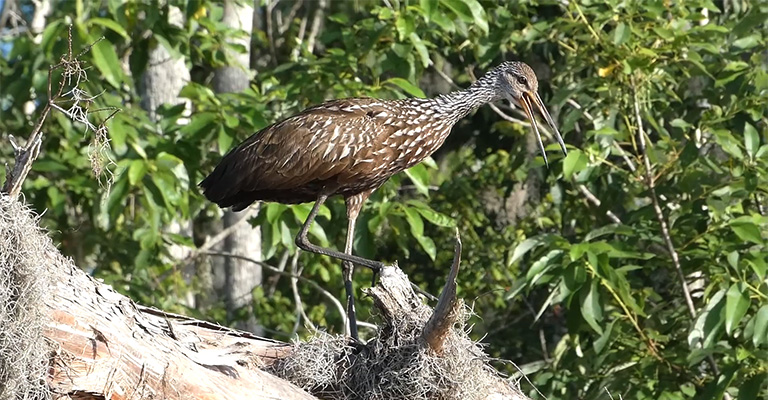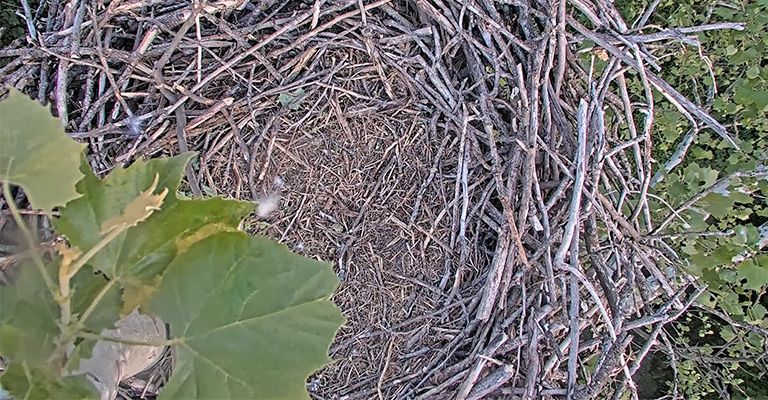Limpkins, a unique bird species found in wetland habitats, are known for their distinctive and haunting screams that echo through the night.
This intriguing behavior has puzzled researchers and nature enthusiasts alike, prompting the question: Why do Limpkins scream all night?
Exploring various factors such as their feeding habits, mating rituals, and territorial behavior, this topic delves into the underlying reasons behind Limpkins’ nocturnal vocalizations, shedding light on the fascinating world of these enigmatic birds.
So, if you are also confused about why Limpkins scream all night, this is the right place for you to learn it. Let’s start the discussion.

Essential Facts about Limpkins
Before we discuss the behavior of Limpkins in the context of nighttime screaming, it is essential to learn about some of their common features.
Background Information on Limpkins
Limpkins have a unique physical appearance that sets them apart from other bird species. They have medium-sized bodies with long legs, a long neck, and a slightly curved bill.
Their plumage is a combination of brown and white, providing excellent camouflage in their wetland habitats. Limpkins prefer marshes, swamps, and other freshwater environments, where they can find an abundant supply of their preferred prey.
Unique Characteristics of Limpkins
One of the most notable characteristics of limpkins is their loud and distinctive call. Described as a piercing scream or squawk, the vocalizations of limpkins can be heard over long distances.
These calls are so unique that they have been compared to someone being strangled to death or a rusty gate swinging open.
The piercing nature of their calls allows them to communicate effectively in their wetland habitats and convey important messages to other limpkins.
Limpkins Nature for Nighttime Calling
While limpkins may be particularly known for their nocturnal calls, they are not the only birds that vocalize during the night. Many other bird species also engage in nighttime calling for various reasons.
For example, owls are famous for their hooting calls during the night, which serve as territorial displays and communication with their mates. Nightjars and whip-poor-wills are other examples of birds known for their vocalizations during the night.
This nocturnal behavior is an adaptation to their ecological niche and the specific challenges they face in their environments. Overall, limpkins are unique birds with their loud and unmistakable calls. Their physical features and habitat preferences make them well-suited to thrive in wetland ecosystems.
While they may be known for their nighttime calling, it’s important to recognize that other bird species also engage in similar behavior.
Territorial Defense

Territorial behavior in birds refers to the defense and maintenance of an exclusive area by an individual or a breeding pair. This territory serves as a crucial resource for birds, providing them with access to food, mates, and suitable nesting sites.
By establishing and defending a territory, birds can ensure their survival and reproductive success.
Use Their Calls to Defend Their Territory
Limpkins employ their loud calls as a primary means of defending their territory. When an intruder or potential rival encroaches upon their established boundaries, limpkins unleash a series of piercing screams or squawks.
These calls serve as a vocal warning, communicating the presence and readiness of the defending limpkin to protect its territory.
Anecdotes of Territorial Disputes Among Limpkins
Territorial disputes among limpkins can be intense and noisy affairs. When two or more limpkins encounter each other within overlapping territories, vocal confrontations often ensue.
These encounters can involve prolonged calling bouts, as each limpkin asserts its dominance and attempts to deter the other from entering its territory.
Anecdotes from birdwatchers and researchers reveal the intensity of such territorial disputes. Limpkins can be seen engaging in aggressive behaviors, such as bill-pointing, lunging, or even brief physical altercations.
These interactions highlight the determination and persistence of limpkins in defending their territories.
Impact of Nocturnal Calling on Maintaining Territorial Boundaries
Nocturnal calling plays a crucial role in maintaining territorial boundaries among limpkins. By vocalizing at night, limpkins remind both their neighboring rivals and potential intruders of their presence and assert their territorial claims.
The persistent and piercing nature of their calls ensures that their message carries over long distances, effectively demarcating their territory and reducing the likelihood of encroachment.
The impact of nocturnal calling goes beyond immediate confrontations. By establishing and reinforcing territorial boundaries through vocalizations, limpkins create a system of communication that helps regulate the spatial distribution of individuals within a population.
This spatial organization can enhance the efficiency of resource utilization and reduce direct physical confrontations, thereby promoting the overall survival and reproductive success of limpkins in their wetland habitats.
Mating Displays

Limpkins have a specific breeding season during which they engage in courtship rituals to attract mates. The timing of the breeding season can vary depending on the region and local environmental conditions.
During this period, male limpkins actively seek out females and engage in elaborate displays to demonstrate their suitability as mates.
Use Their Calls to Attract Females
Male limpkins employ their calls as a primary tool for attracting females. Their loud and distinctive vocalizations serve as a form of advertisement, signaling their presence, location, and readiness to potential mates.
Male limpkins often position themselves in prominent perches, such as trees or elevated branches, where they can project their calls over long distances.
Significance of Loud and Persistent Calling for Mating Success
The loudness and persistence of male limpkins’ calling are crucial for mating success. The intensity and duration of their calls demonstrate their vigor, health, and strength to females.
The ability to sustain prolonged vocalizations indicates high energy levels and physical fitness, which are desirable traits in potential mates.
Importance of Vocalization in Demonstrating Fitness and Attracting Mates
Vocalization plays a significant role in demonstrating fitness and attracting mates among limpkins. The quality and complexity of their calls serve as honest signals of genetic quality and overall health.
Females evaluate male limpkins based on the richness, clarity, and consistency of their vocalizations. Males with more impressive vocal displays are more likely to be selected as mates, as their calls indicate their genetic fitness and ability to contribute to the survival and success of offspring.
Moreover, vocalizations allow limpkins to assess potential mates. Female limpkins pay attention to the calls of males, evaluating their strength, vocal prowess, and overall attractiveness.
Males that display exceptional calling abilities are more likely to capture the attention and interest of females, increasing their chances of successful courtship and breeding.
Communication

For communication, Limpkins simply uses a lot of strategies. You need to understand them as well to get the point of their night screaming.
The Role of Vocalizations in Bird Communication
Vocalizations serve as a primary mode of communication for birds, enabling them to convey information, establish social bonds, and coordinate group activities.
Birds utilize an extensive repertoire of calls to communicate various messages, including territorial defense, mating displays, warnings, contact calls, and more.
Vocalizations allow birds to share information about their identity, location, emotional state, and intentions.
Different Types of Calls Limpkins Use to Convey Messages
Limpkins employ a diverse range of calls to convey different messages. Some of the common call types include territorial calls, alarm calls, contact calls, and courtship calls.
Territorial calls are loud and piercing, used to defend their territory and establish boundaries. Alarm calls are sharp and sudden, signaling the presence of potential threats.
Contact calls are softer and serve to maintain contact within a group or between mates. Courtship calls are more complex and melodious, used during courtship rituals to attract mates.
Specific Messages Limpkins May Communicate Through Calls
Limpkins communicate various messages through their calls. Territorial calls communicate ownership and defend boundaries, warning other limpkins to stay away.
Alarm calls alert nearby individuals of potential dangers, such as predators or intruders. Contact calls help maintain group cohesion, allowing limpkins to stay connected with their mates or offspring.
Courtship calls are used to attract and communicate with potential mates, conveying interest, availability, and genetic fitness.
Importance of Vocal Communication in Maintaining Social Bonds and Coordination
Vocal communication plays a crucial role in maintaining social bonds and coordination among limpkins. By vocalizing, limpkins can identify and locate their social partners, ensuring group cohesion and coordination of activities such as foraging or nesting.
Vocal signals allow limpkins to maintain contact, coordinate movements, and convey information about resources, potential threats, or reproductive opportunities.
The ability to communicate effectively through vocalizations strengthens social bonds and enhances group dynamics within the limpkin population.
Environmental Factors

The environment also places a bigger impact on this context. The following factors are essential to learning about the Limpkins’ nature.
Influence of Environmental Conditions on Limpkins’ Calling Behavior
Environmental conditions have a significant impact on limpkins’ calling behavior. Factors such as temperature, humidity, wind patterns, and vegetation density can influence the frequency, intensity, and timing of their vocalizations.
Limpkins adjust their calling behavior based on these environmental cues to maximize the effectiveness of their communication and minimize energy expenditure.
Factors That May Trigger Increased Vocalizations
Certain factors can trigger increased vocalizations among limpkins. For example, during the breeding season, when competition for mates is intense, males may engage in heightened calling activity to attract females and establish their dominance.
Environmental cues such as the presence of potential rivals, changes in light levels, or the proximity of suitable nesting sites can also trigger increased vocalizations as limpkins respond to these stimuli.
Impact of Moonlight, Water Sources, and Other Stimuli on Calling Patterns
Moonlight and water sources play a significant role in influencing limpkins’ calling patterns. Limpkins are often more active and vocal during moonlit nights, as increased visibility allows them to navigate their surroundings more effectively.
Water sources, such as rivers, lakes, or wetlands, serve as important focal points for calling activity. Limpkins may call more frequently and persistently near water sources as they establish territories, search for mates, or communicate with other individuals.
Other stimuli, such as the presence of potential prey or the calls of other bird species, can also elicit vocal responses from limpkins.
For instance, the sounds of prey items like snails or crayfish in the water may trigger excited calls as limpkins locate and capture their food.
Additionally, interactions with other bird species, such as herons or ibises, can lead to vocal exchanges and territorial disputes, influencing limpkins’ calling behavior.
How Limpkins Adapt Their Calling Behavior to Environmental Cues
Limpkins exhibit remarkable adaptability in their calling behavior in response to environmental cues. They can adjust the timing, intensity, and frequency of their calls based on factors such as ambient noise levels, wind conditions, or the presence of other individuals.
Limpkins may modify their calls to be more distinct and carry over longer distances when environmental conditions require enhanced communication efficiency.
This adaptability allows them to optimize their vocalizations for effective territorial defense, mate attraction, and social interactions.
By adapting their calling behavior to environmental cues, limpkins enhance their chances of successful communication and resource acquisition.
Their ability to flexibly respond to environmental stimuli demonstrates their adaptability and evolutionary fitness within their wetland habitats.
Nest Protection

The night screaming of Limpkin is also related to their behavior of night screaming. Here are the facts you need to know.
Limpkins’ Nesting Behavior and Parental Instincts
Limpkins exhibit dedicated parental instincts and invest significant effort in nest building and caring for their offspring. They construct nests near water, typically in dense vegetation or on elevated platforms, to provide protection and camouflage for their eggs and chicks.
Limpkins demonstrate strong territoriality around their nest sites and are highly vigilant in defending themselves against potential threats.
How Vocalizations Are Used to Protect Nests and Offspring
Vocalizations play a crucial role in protecting limpkin nests and offspring. When perceived threats approach their nest, limpkins utilize their vocal repertoire to issue warning calls.
These warning calls serve as alarm signals to alert their mate or nearby limpkins about the presence of potential predators or intruders. By vocalizing, limpkins communicate the need for heightened vigilance and defense.
Limpkins Intensifying Calls in Response to Perceived Threats
Limpkins intensify their calls in response to perceived threats to their nests or offspring. When a predator, such as a raccoon or a snake, approaches the nest, limpkins may emit more frequent, loud, and aggressive calls to deter the intruder.
These intensified calls serve as a clear warning, notifying the predator that the nest is defended and that any further approach will result in a potential attack from the limpkins.
Role of Vocalizations in Deterring Predators and Ensuring Nest Survival
Vocalizations play a vital role in deterring predators and ensuring the survival of limpkin nests. The loud and persistent calls of limpkins draw attention to their presence and assertive defense.
Predators are less likely to approach a nest when they encounter vocal and visually vigilant parents. The vocalizations of limpkins can convey the message that the nest is actively protected, increasing the likelihood of predators seeking easier targets elsewhere.
Furthermore, vocalizations can also alert other limpkins in the vicinity to join in the defense. When multiple limpkins unite their vocal efforts, the intensity and complexity of the calls can intimidate and discourage predators, increasing the chances of nest survival.
By utilizing vocalizations as an integral part of their nest protection strategy, limpkins enhance their nest survival rates and the overall reproductive success of their species.
Vocal communication acts as a defensive mechanism, deterring predators, and mobilizing a collective defense effort to safeguard their nests and ensure the survival of their offspring.
Coexisting With Limpkins
There are some issues about their coexistence that are also related to the behavior of Limpkin. Please check them right below.
Disturbance Caused by Nocturnal Calling for Humans
It is important to recognize that the nocturnal calling of limpkins can be disruptive to human residents, especially those living in close proximity to their habitats.
The loud and persistent vocalizations may interfere with sleep or cause annoyance, particularly if they occur in residential areas. Acknowledging the disturbance caused by their calls is the first step toward finding solutions for coexistence.
Understanding and Respecting Natural Behavior of Wildlife
Understanding and respecting the natural behavior of wildlife, including limpkins, is essential for coexistence. Limpkins have evolved to vocalize at night as a part of their territorial and mating behaviors.
Recognizing that their vocalizations are a natural expression of their needs and instincts helps foster a sense of empathy and appreciation for their role in the ecosystem.
Suggestions for Mitigating Disturbances While Preserving Limpkins’ Behavior
While it may not be possible to completely eliminate the noise generated by limpkins, there are strategies to mitigate the disturbances while still preserving their behavior:
Soundproofing
Consider soundproofing measures for homes located near areas where limpkins are known to vocalize. This can involve installing soundproof windows, insulation, or other noise-reducing materials to minimize the impact of the calls.
Landscaping and Buffer Zones
Planting dense vegetation or erecting natural barriers can create buffer zones between residential areas and the habitats of limpkins.
This can help dampen the sound and provide a physical barrier that reduces the transmission of vocalizations.
Community Education
Educate local communities about limpkins and their behaviors. Foster an understanding of the importance of protecting and preserving wildlife, emphasizing the ecological roles that limpkins play.
Encourage residents to appreciate and coexist with the natural environment.
Encouragement to Seek Guidance From Local Bird Experts
If the disturbance caused by limpkins becomes a significant concern, it is advisable to seek guidance from local bird experts, wildlife authorities, or environmental organizations.
These professionals can provide specific advice tailored to the local context and offer suggestions for managing the impact of limpkins’ vocalizations.
They may be able to provide insights into the behavior of limpkins in the area and propose strategies for mitigating disturbances while still respecting the natural behavior of these birds.
By taking these measures and seeking guidance, it is possible to strike a balance between mitigating disturbances caused by limpkins’ calls and preserving their natural behavior.
Coexisting with limpkins and other wildlife requires a proactive and understanding approach that considers the needs of both humans and the natural environment.
FAQs
Limpkins are protected under various wildlife protection laws in their native range. The specific regulations may vary depending on the country, state, or region.
It is important to consult local wildlife authorities or conservation agencies to understand the legal protections in place for limpkins and any specific guidelines for coexisting with them.
Limpkins generally exhibit defensive behavior rather than aggression towards humans or pets. They are more likely to vocalize or display warning behaviors to deter potential threats or intruders.
However, it is advisable to maintain a respectful distance and avoid disturbing their nests or young to minimize the risk of any defensive responses.
You can support limpkin conservation efforts by engaging in habitat restoration projects, volunteering with local wildlife organizations, or contributing to research initiatives focused on limpkin populations.
Additionally, raising awareness about limpkins and their conservation needs in your community can help foster appreciation and support for their protection.
Aside from their vocalizations and territorial behavior, limpkins have a diet primarily consisting of snails and other aquatic invertebrates. They have long, curved bills adapted for extracting snails from their shells.
Understanding their feeding habits and preferred habitats can provide insights into their overall ecology and contribute to efforts to coexist with them.
Wrapping Up
The incessant nighttime screams of Limpkins hold deeper significance than mere noise. While the exact reasons behind their vocalizations may vary, a combination of factors such as territorial defense, communication, and courtship rituals likely contribute to this behavior.
Limpkins’ unique ecological niche as wetland dwellers and their reliance on snails as a primary food source further enhance the understanding of their nocturnal screams.
However, despite our growing knowledge, there is still much to uncover about these captivating birds and their mysterious vocalizations. Hopefully, you’ve learned the facts very well. Still, if you have any questions, please let us know. Thank you.